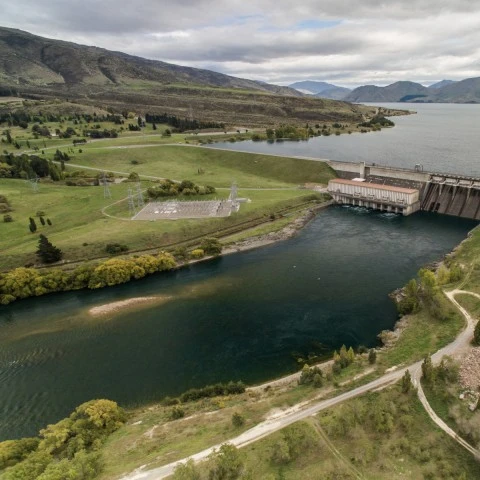Waitaki was a ‘make work’ project during the 1930s’ depression and spawned the trial scheme of the world’s first social welfare system.
The station is eight kilometres upstream from the township of Kurow, where its Doctor, D G McMillan, Reverend A Nordmeyer and local headmaster, Mr A M Davidson, developed a system aiming to provide free medical treatment to workers and their families if they paid a small weekly sum into a common fund.
Later, Dr McMillan and Reverend Nordmeyer became Cabinet Ministers and helped develop a similar scheme for the whole country. New Zealand’s new national social welfare scheme was subsequently implemented in 1939.
Hydro scheme towns
Otematata
Otematata township was developed in the late 1950s to house the workforce needed to build the Benmore and Aviemore dams and power stations. Its population swelled to more than 4000 in 1963.
When the Ministry of Works staff transferred to Twizel in the late 1960s, many of the houses in Otematata were sold as holiday homes. Now Otematata is a popular holiday destination, with lakes, rivers, camping grounds and a golf course within easy reach.
The Māori name ‘Otematata’ means ‘Place of good flint’.
Twizel
Twizel township was built specifically as a residential base for workers on the Upper Waitaki hydro scheme. Its name is taken from the Twizel River that flows nearby.
In 1977, 11 years after it was established, Twizel reached its maximum population of 6000. The local primary school became the largest in the country with 1000 pupils. Twizel’s population dwindled to around 1300 after the bulk of the Waitaki development was completed in the mid-1980s, and now the community focuses on tourism.
Building the Waitaki hydro scheme
The New Zealand government recognised the electricity generation potential of the Waitaki Valley as early as 1904. However, work on the large-scale project only began in the 1920s. The Waitaki dam was the first station to be built on the Waitaki River, as a ‘make work’ project during the Depression of the 1920s and 30s.
In 1958, the Mid-Waitaki hydro scheme began with the construction of Benmore dam and the DC link. This was the start of a unified power transmission system for the whole of New Zealand. The scheme was completed in 1968 with the commissioning of Aviemore power station.
The Upper Waitaki hydro scheme began in 1968 in response to New Zealand’s increased need for power. Work continued until 1985 when the last station, Ōhau C, was commissioned.
During that time four hydro stations were constructed, along with two dams and six canals (totalling 56 kilometres).
Key dates
- 1928 Work starts on the Waitaki dam, as a ‘make work’ project during the Depression of the 1930s
- 1968 Work starts on the Upper Waitaki hydro scheme
- 1999 Meridian Energy forms and is assigned ownership of the Waitaki Scheme
- 2011 Tekapo A and B hydro stations are sold to Genesis Energy
